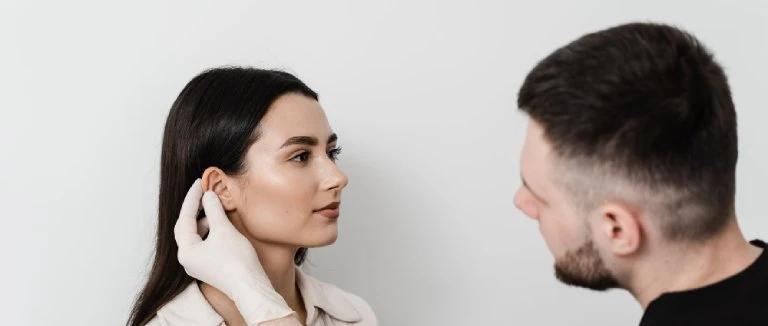Prominent ear surgery is a surgical procedure performed for the purpose of reshaping the auricle if the ears have a protruding appearance. Thanks to prominent ear surgery, the patient's ear deformity gets a better appearance. In order for the postoperative recovery process to pass quickly and complications not to be seen, it is necessary to follow the doctor's recommendations and make the necessary care applications. You can read the rest of the article for more comprehensive answers to the questions of "What is a prominent ear?" and "How is the prominent ear fixed?".

What Is Prominent Ear Surgery (Otoplasty)?
Prominent ear surgery is an aesthetic operation performed for the purpose of reshaping the ears if there is a protrusion of the ears or an appearance of large ears. This procedure is also called otoplasty in medicine. Surgery allows the ears to have a more symmetrical and aesthetic appearance and is usually preferred due to dissatisfaction with the external appearance of the ears. Although otoplasty is common among children and teenagers, it may be suitable for people at any age. The procedure can also be performed due to earlobe problems.
How is Prominent Ear Surgery (Otoplasty) Performed?
Prominent ear surgery (otoplasty) is performed by cutting and reshaping the cartilage tissues located behind the auricle and removing them when necessary. Although surgery is not the same for everyone, it is performed under local anesthesia in children, and under general anesthesia in adults and can take several hours. After the operation, patients may usually feel slight pain, swelling and bruising. After surgery, patients are usually discharged on the same day and can return to their normal activities within a few days.
What Should Be Taken into Account After Prominent Ear Surgery (Otoplasty)?

After prominent ear surgery, it is necessary to follow the doctor's recommendations and go to regular follow-up appointments in order for the healing process to pass more healthily and quickly. Some factors that should be considered after prominent ear surgery are as follows:
- Resting in the first days after surgery and using a pillow that keeps the head high, especially when lying down.
- Regularly using painkillers, antibiotics or other medications recommended by the doctor.
- Performing the necessary wound care to ensure that the wound area remains clean and dry.
- Avoiding exercise and other activities for several weeks after surgery.
- Not wearing clothes that can put pressure on the ears.
- Avoiding impacts and blows so that the ears are not damaged.
After prominent ear surgery, it may take a few weeks for the person to return to normal life and for the ears to fully recover. For this reason, it may be beneficial to pay attention to the above-mentioned issues during the healing process.
Is Prominent Ear Surgery (Otoplasty) Risky?
As with any surgical procedure, prominent ear surgery may also involve certain risks. The risks that may occur in this operation are low and complications are rare. In general, some possible risks can be counted as follows.
- Infection in the wound area after surgery
- Bleeding during or after surgery
- Asymmetry problem in the ears
- Temporary or permanent loss of hearing of the ears
- Scars that may occur during the postoperative wound healing process
Before surgery, it is important to discuss the risks and possible complications indicated with the doctor who will perform the procedure and to comply with the doctor's recommendations in order to minimize the risks.
What is the Advantage of Having a Prominent Ear Surgery?
A prominent ear is a condition in which the ear curves outward more noticeably than usual. Aesthetic concerns may arise in people who have this condition, and some people may be quite uncomfortable with this condition. With ear aesthetics, an increase in self-confidence, a better aesthetic appearance, being more comfortable in social life, a permanent solution and recovery can be achieved in a short time. Comments after prominent ear surgery, on the other hand, usually contain satisfaction.
What is the Disadvantage of Having a Prominent Ear Surgery?

There may be disadvantages to having a prominent ear reduction surgery, albeit rarely. These may include risks related to general anesthesia, risks such as infection, bleeding, scars, and aesthetic consequences such as asymmetry in the ears. In such cases, there may be problems such as the operation not giving the desired result, or repeated operations.
Is There an Age Range For Prominent Ear Surgery?
There is no specific age range for prominent ear surgery. In order for the operation to take place, it is usually expected that the development of the ears will be completed. The most appropriate method to decide on the age range for prominent ear surgery is medical evaluations to be performed by an otolaryngologist or plastic surgeon. In these evaluations, the most appropriate treatment plan is determined by taking into account factors such as the structure, size and shape of the ears.
Prominent Ear Surgery For Children (Otoplasty)
Prominent ear surgery is usually considered a safe procedure for children. Prominent ear surgery (otoplasty) for children is usually performed between the ages of 4 and 14. At this age, the ears become proportional to other parts of the child's body, and the growth rate of the ears slows down. For this reason, symmetry problems that can be seen after surgery are less common and the effect of surgery is higher.
Prominent Ear Surgery For Adults (Otoplasty)
Prominent ear surgery (otoplasty) is a procedure that can also be performed for adults. However, since the growth rate of adult ears is slower than that of children, the shape and size of the ears may change less after surgery.
Prominent Ear Surgery Prices
The price of prominent ear surgery may vary from the region and equipment of the healthcare institution to factors such as the experience of the doctor who will perform the operation and the general health status of the patient. Ear aesthetics prices may also vary depending on the type of insurance that the person is affiliated with. It is not possible to specify a clear price because otoplasty prices are generally determined on a personal basis.
Frequently Asked Questions About Prominent Ear Surgery:
How long does prominent ear surgery take?
Although the duration of the prominent ear surgery depends on the shape, size of the person's ears and the method in which the operation will be performed, it usually takes 2-3 hours.
For how many days do patients feel pain after prominent ear surgery?
Mild to moderate pain may be felt during the first few days after prominent ear surgery. The observed pains can be reduced with pain-killers and ice compress applications used on the recommendation of a doctor.
Is prominent ear surgery easy?
The easiness of prominent ear surgery may depend on the person's ear shape, size and the method in which the operation will be performed. Some techniques are more complex, while some techniques may be simpler and less invasive (surgical incision).
When does the swelling go down after prominent ear surgery?
After prominent ear surgery, most of the patients may experience slight swelling and bruising at the surgical site. The swelling usually starts to decrease during the first week and becomes less noticeable towards the end of the second week.
Does the ear return to its former state after prominent ear surgery?
After the prominent ear surgery, the shape of the ears is changed and made compatible with the head. Therefore, it is unlikely that the ears will completely return to their previous state after surgery.
When does the prominent ear surgery scar fade?
Scars formed after prominent ear surgery usually decrease and become pale over time with the healing of the skin at the surgical site. It may take a few months to a year for the scars to completely disappear.
How many days after the prominent ear surgery can patients take a shower?
It is usually not recommended to take a shower for several days after prominent ear surgery. The reason for this is to prevent the surgical site from becoming susceptible to infection.
Can the prominent ear be corrected without surgery?
The most effective method of correcting the prominent ear problem is surgical intervention. Non-surgical methods can be used only in cases of slightly prominent ears and in young children. Some of these methods are bands, hats and some apparatus.
If you or your child have a prominent ear condition, you can contact a medical institution to get more information and have the procedure performed.
Breast reduction is a type of breast aesthetic operation that can be performed for many different reasons. The operation is performed in the form of surgery at Liv Hospital Plastic, Reconstructive and Aesthetic Surgery. It is performed to make the breasts smaller, lighter and shaped. Women and men can benefit from this breast aesthetics operation.
What is Breast Reduction Surgery?
Breast reduction surgery, or reduction mammoplasty as it is medically called, is a procedure that serves to provide a breast size that is more proportional to the patient's body and to prevent disorders caused by excessively large breasts (macromastia). Disproportionately large breasts may lead to posture problems, physical and mental distress and pains. Patients with large breasts may have some physical activities restricted in daily life, they may have back pain, or people may be uncomfortable just because of their aesthetic appearance. Breast reduction surgery is an operation that provides a solution to such situations. Usually, surgery to relieve these and similar symptoms is also preferred by people who do not have symptoms but are not satisfied with the size of the breasts.
How is Breast Reduction Surgery Performed?
Breast reduction surgery is performed under general anesthesia. It usually takes between 2 and 5 hours. There are several different surgical methods that can be used. The specialist physician who will perform the procedure performs the operation by choosing one of these different methods depending on the shape and size of the breast. These methods are:
Liposuction Method: The surgeon inserts a tube into the vacuum device by opening small incisions in the area of the procedure. This tube works by pulling fat and liquids out of the breast. This method is preferred when less breast reduction will be performed, that is, if the breast is smaller and it is thought that the skin can compensate for the difference.
Lollipop Method or Vertical Incision: This method is preferred if a moderate reduction is to be performed or if sagging in the breast is desired to be corrected. The surgeon makes incisions from around the areola (the colored area around the nipple) to the area under the breast, and removes excess tissue and fat, shapes the breast and lifts the breast.
Reverse T Incision method (Anchor Method): This method is performed by making incisions along the lower fold of the breast, towards the bottom of the areola by the surgeon. It is usually preferred for large breast reductions and in cases where there is a lot of sagging or unevenness.
Since breast surgery is a major surgical operation (i.e., general anesthesia is used), the patient stays in the hospital for one day after the surgery.
For Whom Is Breast Reduction Surgery Performed?
Everyone with a large chest size is a candidate for problems caused by this condition. A large chest is the cause of back pain. In addition, it can restrict various physical activities, negatively affect psychological and physical health, and lead to aesthetic discomfort. However, whether or not to have surgery is entirely the choice of people. When women and men need it, they can have this surgery and see the benefits.
How Is Breast Reduction Surgery Performed on Women?
Large breasts, especially breasts that are not proportional to the size of the body, can lead to many problems in women. Back, neck, breast and shoulder pain are foremost problems. There may be pain and injury caused by a bra strap on the shoulders. Difficulty finding clothes suitable for the upper body is also a common condition. In addition, large breasts can also cause difficulties during physical exercise. Breast reduction surgery gives positive results in women suffering from these conditions.
How Is Breast Reduction Surgery Performed on Men?
The condition in which one or both breasts are larger than normal in men is called gynecomastia. Gynecomastia can occur as a result of hormonal imbalance or as a result of breast tissue growth due to excessive weight-increasing estrogen levels. Breast reduction surgery is a good option for men with gynecomastia. If there is a proportional size in the breasts due to just being overweight, or obese, this surgery is not performed.
What are the Risks of Breast Reduction Surgery?
The risks associated with breast surgery exist, just like with any surgery. As for general anesthesia, there are problems such as allergic reactions, chest infections, blood clots, heart attacks, stroke, and death, just like all surgeries with general anesthesia. The problems that may occur due to breast reduction surgery can be listed as follows: scars, heavy bleeding, infection, swelling, bruising, pain, healing problems, asymmetry, decreased sensation, damage to deeper structures, and allergic reaction.
It is possible that these problems will arise, but this does not mean that they will definitely occur. Factors such as being healthy and not smoking increase the chances of success of each operation, as well as they are important factors in breast reduction operations. If you need breast reduction surgery but are afraid of these disadvantages, you can find out how much risk you are at by consulting your specialist physician about these fears.
Is There an Age Limit For Breast Reduction Surgery?
There is no age limit for breast reduction surgery. Only breast development should be completed. In the medical literature, this is defined as Tanner stage 5. The doctor you consult can tell you after the examination whether the surgery is suitable for you.
How Long Does Breast Reduction Surgery Take?
Each operation differs depending on various variables. However, to say a general time value; the operation is expected to take at least 2 hours and at most 5 hours. The time may be prolonged depending on the complications that may occur.
What to Pay Attention to After Breast Reduction Surgery
After surgery, a one-day hospitalization is an expected result, as general anesthesia is administered. After the operation, you can walk and do light work within two weeks. It is considered normal for the first two weeks to pass with pain and swelling. During these two weeks, you should not lift heavy things and be alert to the symptoms that your doctor tells you to watch out for. It may take about six weeks for you to return to your normal exercises.
Since breast reduction surgery is performed with different methods, in different sizes, what needs to be paid attention to after surgery for each person will also vary. However, when you see an unexpected symptom after surgery, that is, if your wounds heal late, if you see swelling in an unexpected area, or if you suspect problems such as inflammation or loss of sensation, it may be useful to contact your doctor without wasting time.
Breast Reduction Surgery Prices
Breast reduction surgery prices will vary depending on where you prefer to have the surgery. You can consult the healthcare institutions where you want to have surgery to get information about this.
Frequently Asked Questions:
Does a scar remain after breast reduction surgery?
Scars may remain on the skin after any operation. Even if there are no problems after surgery, the places where the surgery was performed may look redder, slightly lumpy and puffy. You can help heal these wound sites with dressings and then creams recommended by your doctor. It has been stated that most people do not have very visible scars after recovery. However, this healing process of the skin can take up to two years.
As with any operation, this situation varies from person to person. If you are already prone to scarring, it may be good to discuss this with your surgeon before surgery.
Why do breasts sag?
Breasts of any size can sag, but due to gravity, large breasts are more prone to sagging. In addition, aging, hormone changes, pregnancy, weight gain and loss, and menopause can also cause sagging breasts. There are no studies showing that breastfeeding causes breast sagging.
Is breast reduction surgery an obstacle to breastfeeding?
If you are planning to breastfeed in the near future, it may be a good idea to postpone breast surgery. It is important to remember that the breasts, like the entire body, change during pregnancy and this will affect the outcome of the surgery. Most plastic surgeons prefer to wait for the breast to return to its normal shape after the breastfeeding process for surgery. This is also between 6 and 12 months.
* Liv Hospital Editorial Board has contributed to the publication of this content .
* Contents of this page is for informational purposes only. Please consult your doctor for diagnosis and treatment. The content of this page does not include information on medicinal health care at Liv Hospital .
